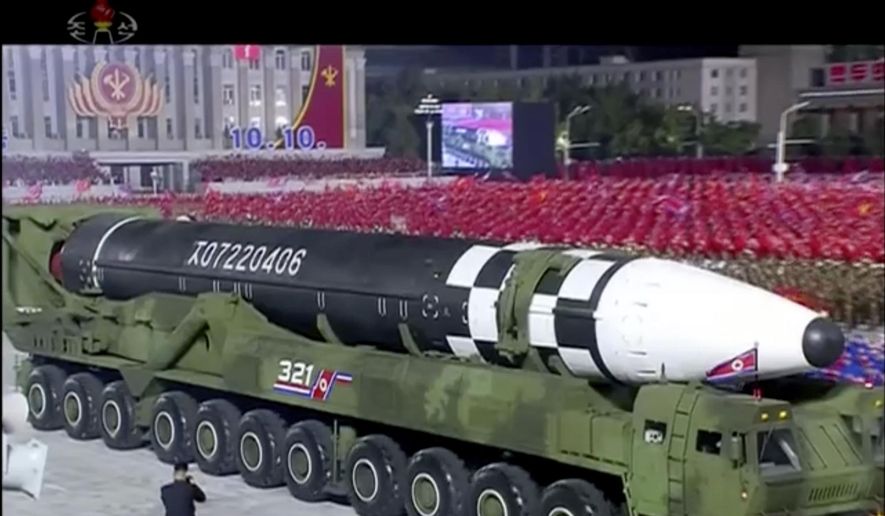OPINION:
After much speculation, our long-promised “October surprise” from our North Korean friends has been revealed. On Oct. 10, North Korea paraded a “monster” intercontinental-range ballistic missile (ICBM), appearing to have capabilities that can give U.S. homeland missile defenses a run for their money.
It’s no surprise that North Korea has been advancing its missile arsenal with the aim of increasing its strategic leverage and prestige. But this revelation should serve as a wake-up call that U.S. defenses are at risk of falling behind Kim Jong-un’s rogue state threat. It should also increase the importance of fielding the Next Generation Interceptor (NGI), intended to reckon with advanced missile capabilities.
While much remains unknown about North Korea’s new ICBM, experts believe it is large enough to carry multiple warheads and decoys meant to overwhelm missile-defense systems. The parade also demonstrated a new capability to produce the vehicles that transport missiles to the field for operational use — called transporter-erector launchers — allowing North Korea to potentially launch more missiles in one strike.
It has been U.S. policy since 1991 to develop and maintain missile defenses against limited or third-world strikes. The current policy, updated by the National Defense Authorization Act for Fiscal Year 2020, is to maintain a missile defense system that can defend against “the developing and increasingly complex missile threat posed by rogue states.”
Today, the United States deploys 44 ground-based interceptors in Alaska and California to defend the homeland from this threat. Earlier this year, the former Commander of U.S. Northern Command, Gen. Terrence O’Shaughnessy, assured the U.S. Senate the system can defend against North Korea today.
But this may not remain the case. Our interceptors are growing old, and the North Korean threat is clearly progressing.
While the Missile Defense Agency deserves credit for working with industry to perform service upgrades to these interceptors, the unveiling of North Korea’s new mammoth missile highlights the importance of moving forward with their replacement program — the NGI.
The Missile Defense Agency introduced the NGI program last year when the planned successor program for the current missile interceptors was killed due to technical risks. The NGI is envisioned to have the advanced capabilities necessary to defend against an increasingly complex threat. While few of its exact requirements are public, reports indicate that NGI would have the capability to kill multiple inbound warheads with one interceptor.
In contrast to today’s interceptors, which carry only one kill vehicle each, a multiple kill vehicle capability can help defend against countermeasures installed in missiles intended to overcome defenses. For instance, if today 10 missiles are launched at the United States, each carrying four objects (whether nuclear warheads or decoys), the United States would need to launch nearly all — 40 of its 44 — interceptors to strike all targets. And that’s if our interceptors had a 100% success rate (they don’t).
With a new NGI capability that carries four kill vehicles on each interceptor, for instance, we’d only have to launch a minimum of 10 missiles, not 40. Under the administration’s plan to increase our interceptor capacity to 64, NGIs with multiple kill vehicles could significantly bolster our defense against advancing North Korean capabilities.
Some critics have argued that to develop a missile defense system capable of overcoming such advancements will be prohibitively costly. They say it would lead to a contest to keep up with a growing and more sophisticated North Korean arsenal.
But these arguments ignore the deterrent value that even an imperfect missile-defense system can provide. By lowering the probability that an attack will succeed, the presence of U.S. missile defenses complicates an adversary’s attack calculus, forcing countries like North Korea to think twice before pushing the nuclear button.
To ensure a viable defense against North Korean missiles for the years to come, the United States must first continue investing in keeping the existing ground-based interceptors effective until the completion of NGI, whose arrival date is uncertain. Despite repeated promises by senior Pentagon leaders to speed up the NGI program, the contract award has already been delayed by several months.
As a result, both the House and Senate defense authorization bills and the House defense appropriations bill for the next fiscal year propose a funding cut to NGI from the President’s budget request. Congress should remain resolute in its ability to provide the funding needed to move forward with the NGI as quickly as possible once the Missile Defense Agency issues a contract award and should hold the Pentagon accountable for any delays.
While North Korea’s new missile may not come as a surprise, it should remind us why defending the homeland from attack is the number one objective of both the National Defense Strategy and the Missile Defense Review.
Upgrading and then replacing America’s missile interceptors must remain a top priority now and into the next administration.
• Patty-Jane Geller is the policy analyst for nuclear deterrence and missile defense in The Heritage Foundation’s Center for National Defense.




Please read our comment policy before commenting.